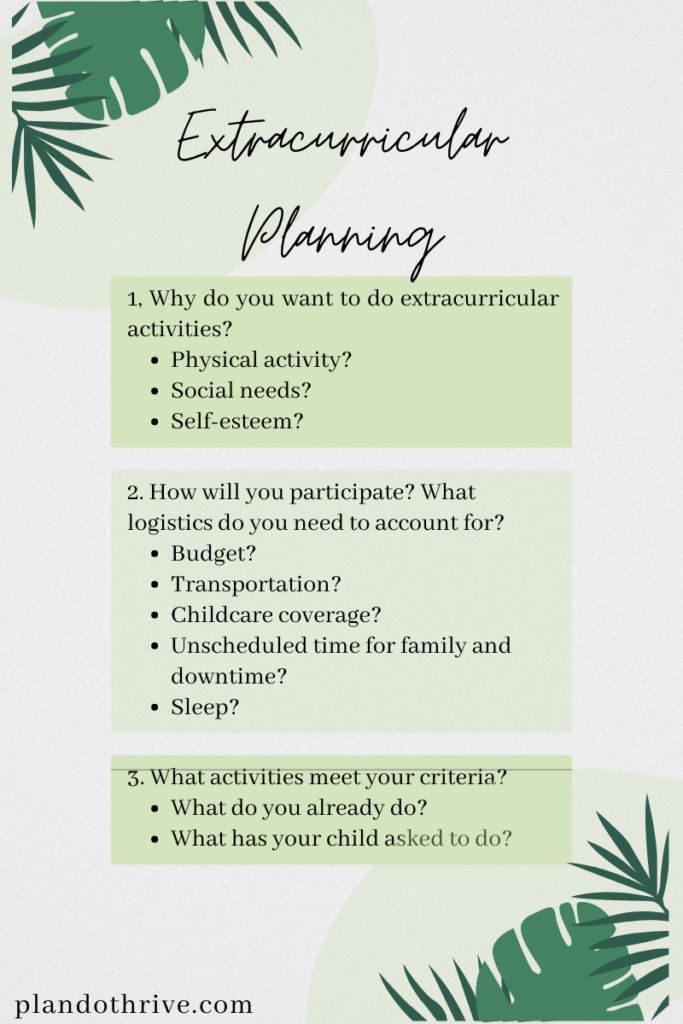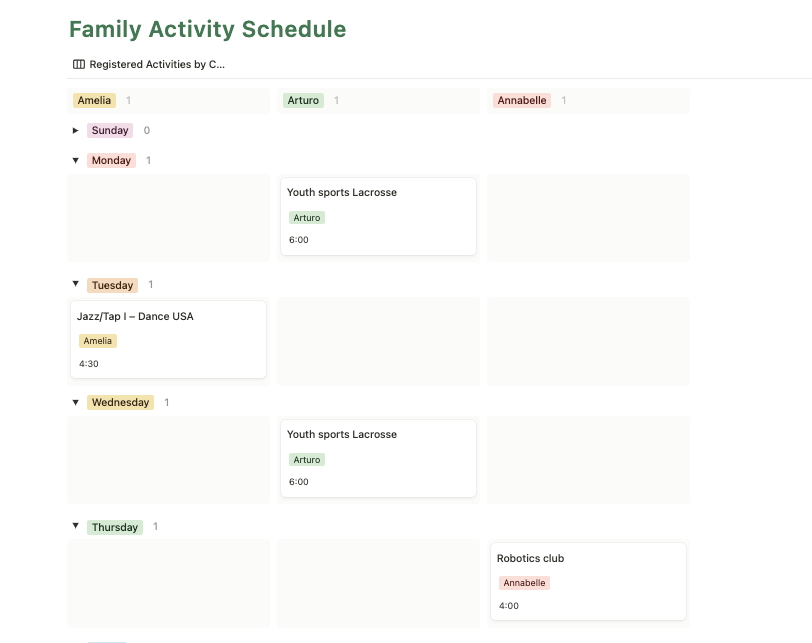How can you create the best extracurricular schedule for your family?
The thing is, there’s so many exciting opportunities! Lego club, Broadway dance, pickleball, ice skating, 3D printing, slime club (I swear it’s a thing, I got this from my kids’ school calendar), soccer, baseball, field hockey, didgeridoo lessons…well, anyway, you know how it goes. There’s so many opportunities, so many options – but obviously, they can’t do them all.
For one thing, there are budget considerations.
And for another…the logistics 🤯. Why is so much of school-aged parenting about logistics?? The more children you have, the higher the multiplier for complications. How will your kids get from point A to point B in the afternoon? Will they have all the equipment they need with them? What about the booster seats? And don’t get me started on planning summer camps.
Plus, what’s the right number of activities? You want your kids to be well-rounded, athletic and artistic, but you also don’t want to overschedule them.
If you are feeling overwhelmed, let me validate that: it is overwhelming. Nobody built this modern world we live in with, you know, parent sanity in mind.
But it can be done.
Let’s take a step back and walk through a process you can use to create an extracurricular schedule that will work for your family. We’ll start with a tiny bit of philosophy, then go through a straightforward, step-by-step process to get this thing done and get you a beautiful schedule that works for everyone.
How to choose extracurricular activities
To some extent, the process of deciding on which activities to participate in is a function of how old your kids are and what activities your kids already do (and, you know, their friends do). However, with each season and school year comes the opportunity for a fresh start, and I’d encourage you to take advantage of it. (Here are more tips for getting organized in the back-to-school season.)
Before you click “register” on anything, take a step back and consider the “why” and the “how” for your child’s extracurricular activities. Because this is a decision for your whole family, and it comes down to designing the life you want to lead. Not to get too dramatic! We can break the process down into some digestible steps.
- Figure out what you value
- Research activity options
- Decide and commit
- Check in
Figure out what you value
The first step is to think through why your child will do extracurricular activities. I would recommend jotting down your answers as you read through this list. If you have a partner, sit down with them and work through the list together.
By the way – I created a Notion template to make this easier and visually appealing. You can grab a copy here. Right now we’re in the “Values Worksheet” section.
Question 1: Why do we want to do extracurricular activities?
What are you hoping for your child to get out of participating in activities? You might consider:
- Physical activity. The CDC recommends one hour of physical activity per day for children, but the average length of recess in the U.S. is only 25 minutes. Will your child make up the difference through organized sports or other activities, or through unstructured play?
- Social needs – do you value activities that allow your child to spend time with friends, or make new friends? Group activities can be important for children to build a sense of belonging, develop friendships, and build relationships with supportive adults, too.
- Self-esteem and self-expression – when kids master a skill, it gives them confidence. Kids who participate in any extracurriculars report higher levels of self-concept and self-worth – with higher levels for those who participate in both sports and non-sport activities.
Some families approach this by having each child participate in one athletic and one artistic activity. Others may try to find a single activity that packs a punch in all areas, or spread a handful of different activities throughout the week.
Question 2: How will we participate? What logistics do we need to account for?

You also need to consider the how. Whereas the why above tends to be more expansive and inclusive, these will be more limiting factors. For example:
- Budget – how much are you planning to spend on after-school activities for your children, and over what period? In addition to upfront or recurring fees, are there equipment, travel, or end-of-year costs you’ll need to account for? (I’m looking at you, dance recital tickets.)
- Transportation – high on the list for many families. If your work schedule does not allow you to drive your child around directly after school, you’ll need to find activities that provide transportation, or that are within walking distance of your child’s school, or that a neighbor is participating in so you can make a carpool agreement. If you’re the driver but have multiple children, you’ll also need to consider how the activities fit together when it comes to driving from point A to B to C to D. Here are some tips on how I use Google Calendar to manage this.
- Childcare coverage – on the flip side, you may be looking for after-school activities that provide supervision for your child from the end of school until you’re able to pick them up, which would rule out any activities that don’t fit your time requirements.
- Unscheduled time: Family time and downtime – What amount of time do you want to set aside as unscheduled time for your kids to do with as they please? Younger kids in particular need time for unstructured play, the longer the better. What about family time? Is it important to you to have dinner together as a family every night? If so, you may find yourself crossing activities off the list that wouldn’t allow for that.
- This is another area where I would pay close attention to the needs your child has expressed both explicitly and implicitly. For example, my younger daughter is often exhausted after school, and needs time to be read to or rest before she’s ready to do anything so active as play outside, let alone get in the car and drive to some activity or other.
- Sleep – on a similar note, consider whether your child will have enough time to get enough hours of sleep per night – 9-12 hours for children ages 6-12, and 8-10 hours for teenagers. What time does that mean they need to get to bed? How much time do you need to reserve for them to eat dinner and do their homework, if they have any? It may be that there simply isn’t enough time to drive to an activity, participate, and drive home on top of their core needs after school.
Question 3: What activities meet these criteria?
Now, work on a list of potential activities. As you do, consider:
- What has my child done in the past? How well did it meet the above criteria?
- What does my child actually want to do? This may seem a little too obvious to spell out. However, it bears considering. Make sure you’re listening to the likes – and, importantly, dislikes – that your child has expressed. Emily Oster says, “The best extracurricular activity for your child may be the one they like — the one they feel comfortable or happy doing — rather than the one they are the best at.”
As you consider all this, remember that kids’ activities are typically broken down into semesters or seasons, and while you may discover that you’d only like to do one or two activities at a time, that could mean one or two in the fall, a different set in the spring, and something new in the summer.
Once you’ve made notes, go back and highlight the must-have requirements, such as childcare or transportation at certain times of day. You’re going to use these as a sieve to rule out any activities that won’t work. Then, consider which value-based items are most important to you. Use this as a compass as you research activities.
For a deeper dive on this line of thinking, I recommend the book The Family Firm by Emily Oster. In it, she goes through an approach you can use to take data and make decisions for your family, particularly focused on the elementary school years.
Research activity options
Okay. Now, it’s time to collect all of the data! Personally, I find this step a bit of fun.
If you have a partner, divvy up the work: for example, you’ll be in charge of researching music lessons and they’ll research swimming. Or, one of you will do all the research and you’ll sit down to make the final call together – whatever works for you.
Based on the values exercise above, you should have a good idea of what activities, and what balance of activities, you’re aiming for. For example, one athletic and one artistic; or one each for three days of the week and nothing on the other four days.
Next, get your materials ready. You’ll want a way to track all the options with days, times, and costs; rule out activities you’ve decided against; see your whole schedule in one view; and track registrations. I’ve set this all up for you in a Notion template if you’d like to start there.
If you’re using the Notion template, first, you’ll need to delete the sample data, and change the childrens’ names to your names.
Next, research activities. Throw all your ideas down on virtual paper. For example, I started with the dance studio my kids went to last year. I made a row in the table for each possible session of Ballet I, plus Contemporary and Broadway classes I thought my daughter might be interested in. I skipped the ones that would run past her bedtime, but included the rest to consider.

Repeat for each child and each potential activity.
Decide and commit – and actually make that schedule
Then, note which sessions/activities you’re most interested in. In the Notion template, you would change the status to “Preferred option.”
Return to your parameters. Rule out anything that doesn’t work. For example, if you highlighted family dinner as a preference, change the status to “decided against” for any activity sessions that would make that impossible. If you have a preferred activity for Tuesday afternoons, perhaps you rule out anything else that happens on Tuesdays. You may use this step to change options – for example, to choose another session of that Ballet I class that doesn’t overlap with the drive time for your other child’s swim class.
Once you’ve done this, take a look at your current working schedule. In Notion, this is the “Preferred and Registered” tab. Does your schedule meet all your logistical needs? Is there enough time for downtime, transportation, and sleep? Make adjustments as needed. Now is a good time to check in on the budget, too, at the Activity Cost Summary table near the top.
Then, it’s time to register. In Notion, head to the Registration Tracker table. This lists everything you’ve marked as a “preferred option”, and serves as your registration to-do list. Once you’ve registered for an activity, change the status to “Registered”.
You’re ready to rock! Use the Family Activity Schedule view to see what your crew’s signed up for. Make sure to add all activities to any shared calendars, such as your Google calendar or fridge calendar.

Check-in
Set a point in advance to check in as a family, and mark it on your calendar. Perhaps this is one month in, or in November before you need to sign up for spring activities. Be clear with your children in advance that this is part of the plan – particularly if they’ve bitten off a large schedule you’re concerned they won’t be able to chew.
This check-in serves two purposes: one, ensure that the activities are working for your child. It really is okay to quit if it’s not a good fit! Plan in advance the parameters under which you’ll allow your kid to quit. Anytime? After three sessions they tell you they don’t want to go? After a sports season or drama performance is over?
The other reason to set this check-in is for you as the parent. Maybe you’ve found that you’re cutting the drive too close and missing out on fifteen minutes of the hour you’re paying for. Or maybe your child is just too tired for swim lessons after school. Make adjustments, and know that you’ve made a thoughtful, holistic plan for your family.
So tell me in the comments: What do you value when creating an extracurricular schedule for your family? What has worked for you?
More posts for parents: Back-to-School Ethical Shopping Guide






